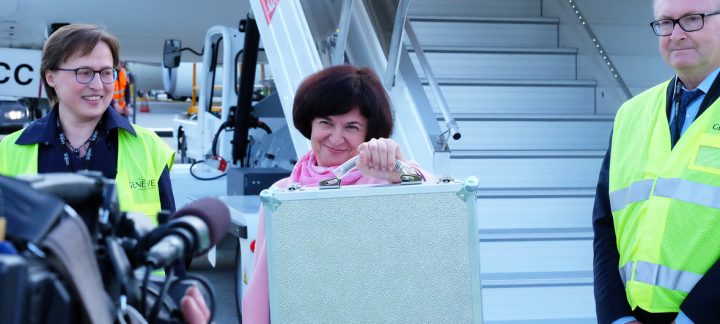For the first time, part of the original manuscript of Tolstoy’s epic novel, War and Peace, has been unveiled amid tight security in Geneva, where it is the highlight of an exhibition helping to mark 100 years of cooperation between nations.
The precious cargo, which is widely regarded as one of the finest novels ever written on humankind’s conflicting desires to fight and live together, arrived late last week at the city’s international airport from Moscow.
Masked and heavily armed Swiss army soldiers clad in black, met the Swiss flight, as Tolstoy Museum Vice-Director Nadezhda Petrova emerged from the jet, clutching a metal briefcase containing six pages of the opus.
Because of the different humidity levels in Moscow and Geneva, they would have to remain out of sight for a little while longer, Mrs. Petrova explained.
The Russian VIP was then escorted around the lake in an armed convoy to Fondation Martin Bodmer, where one of three exhibitions is taking place to mark the centenary of multilateralism in the Swiss city. It is something that the author would have likely supported, she told journalists.
“Tolstoy was always against violence,” she said. “So, he was always against war. I think he would probably always call for peace. And that all the issues, all the problems were solved only by peaceful means – through negotiations.”
Taking pride of place in the “Guerre Et La Paix” (War and Peace) exhibition, the Tolstoy passage covers the period just before the Battle of Borodino in September 1812, between Napoleon’s troops, and their Russian counterparts, believed to number around 250,000 in all.
“So these draft pages, written between 1864 and 1869, have left Russia for the first time, and it’s the first time they have left the Tolstoy Museum in Moscow too,” explained Jacques Berchtold, Director of Fondation Martin Bodmer.
Although the fighting causing tens of thousands of casualties and cleared the way for Napoleon to march on Moscow, it famously proved to be an ultimately unsuccessful campaign.
It was the futility and barbarity of conflicts like this that Tolstoy wanted to describe in detail as a warning to others in book three of the more than 1,000-page epic, Mr. Berchtold insisted.
“We have chosen a conversation that’s particularly intense and dramatic, between the protagonist of the book, who’s the Count Pierre (Bézoukhov) and one of his best friends, who’s an officer in the Russian army, and who’s going to fight Napoleon in the Battle of Borodino”, he said. “And just before this battle, the Count – the Prince Andrej – who is himself an officer, speaks with utter desolation. He says very clearly that the war cannot be compared at all to a game of chess, that war is a totally dirty, detestable affair.”
Although more than 200 years separate the world of War and Peace from our own, Tolstoy’s preoccupation with the human condition – and his support for pacificism – remains relevant today, said Pierre Hazan, human rights expert and one of the driving forces behind “Guerre et La Paix”.
“The world of Tolstoy is obviously radically different to ours; but what’s at stake is the same, the need for concord, the need for discussion, the need for multilateralism, the need for dialogue between different cultures, so yes, it’s essential that Tolstoy is part of this period of reflection today.”
This re-examination of the need for international cooperation is taken up elsewhere in Geneva, in exhibitions at the United Nations and at the International Committee of the Red Cross – where Martin Bodmer was Vice-President between 1947 and 1964.
The link between Tolstoy’s writings and a wider wish by some nations to tackle the enduring horror and constant threat of war, is clear, Mr. Berchtold insisted, pointing to co-founder of the Red Cross, Henri Dunant.
“The same year that he wrote War And Peace, Henry Dunant chose to show another war happening at the same time: the Battle of Solferino, between the French and Austrians, in Italy,” he said.
“Dunant shows, a bit like Tolstoy, a war that’s directly contemporaneous, the atrocities, the dying, the war-wounded whose agony is interminable”.
I think he would probably always call for peace. And that all the issues, all the problems were solved only by peaceful means; through negotiations – Tolstoy Museum Vice-Director, Nadezhda Petrova
At the UN in Geneva, an exhibition on the evolution of 20th century international cooperation through the eyes of the League of Nations and the United Nations shows that while the jury is still out on exactly what multilateralism has meant in the past, and what it means today, the international community can still make a collectively positive difference.
Just after the First World War, when the League of Nations was founded, “at that time in history the Member States were not really ready to renounce war as a means for conducting foreign policy”, explained Stefan Vukotic, Chief of the Archives Management Unit in the Institutional Memory Section at the UN Library in Geneva. “It became clear after a while that this mission of the League of Nations was not going to be as successful as they had originally envisaged, so they focused more on the technical side of cooperation, so the League did wonderful things in this respect that were later taken over completely by the UN”, he said, citing for example the standardization of vaccines and medicines,
Maintaining that the United Nations “learned the lessons” of the League of Nations’ failure to prevent the Second World War, Mr. Vukotic pointed out that the founding Charter of 1945, explicitly prohibited war as a means of conducting foreign policy, except in exceptional circumstances. “The League’s Covenant didn’t explicitly prohibit war, it just asked Member States to refrain from war whenever possible.” he said.












